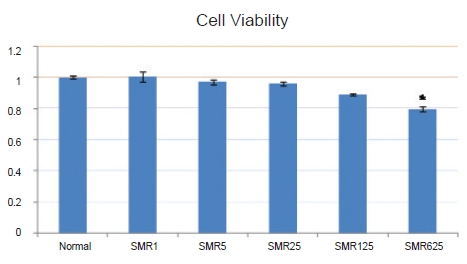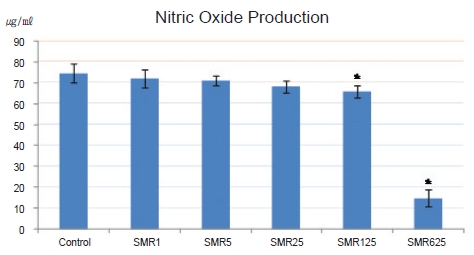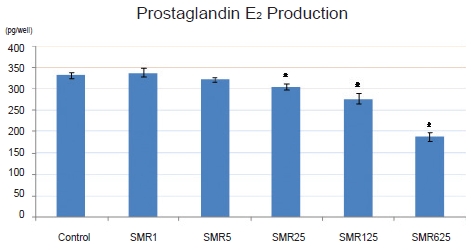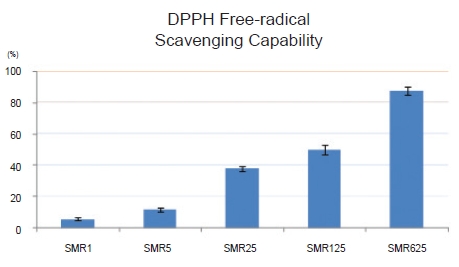Inflammation is one of the self-protective abilities against tissue injury, and it has clinical symptoms like pain, heat, redness, and loss of function [1]. If severe inflammation occurs, organs and cells may be destroyed, and changes such as decomposition of proteins and suppression of DNA synthesis may be caused by oxidative stress [2].
Salviae Miltiorrhizae Radix is obtained from the dried root rhizome of Salvia miltiorrhiza Bunge, which belongs to the Labiatae family as a perennial herb. Usually, it is gathered in spring and autumn and is washed and dried before use. Its effects, such dispelling blood-activated stasis, controlling menstrual pain, blood-culturing mind relaxation, and dispelling blood-cooling furunculus, are reported in the literature on Korean medicine [3].
The study of Salviae Miltiorrhizae Radix has been advanced with subjects, and it may have an effect on cell inflammation [4-6], injured cells and muscles [7-9], and tumor cells [10]. Therefore, we surmise that it may have anti-inflammation, antioxidant efficacy, but sufficient evidence supporting this hypothesis does not exist. Thus, to investigate the anti-inflammation, antioxidant effect of Salviae Miltiorrhizae Radix hot aqueous extract, we designed an experiment to study its influence on NO (nitric oxide) and PGE2 (prostaglandin E2) production and on DPPH (1,1-diphenyl-2-picryl hydrazyl) radical scavenging in LPS (lipopolysaccharide)-induced macrophages.
For experimentation, we purchased Salviae Miltiorrhizae Radix from HMAX Co., Ltd., of South Korea. For preparing the hot aqueous extract, first, we extracted 300 g of Salviae Miltiorrhizae Radix in 2 L of distilled water at 100℃ for 4 hours. Next, the volume of the filtered extract was reduced to 100 mL by using a rotary evaporator (KORPROTECH, Korea); then, the extract was frozen at –80℃. Lastly, the reduced-volume extract was freeze-dried by using a freeze-drying system (Labconco, USA) for 7 days. The last yield of the material was 18% (54 g).
The RAW 264.7 macrophages that were used in this experiment were parceled out from ATCC: The Global Bioresource Center (Manassas, USA). Afterward, we cultured the cells by using Dulbecco’s modified Eagle’s medium (DMEM) including 10% fetal bovine serum (FBS) and 1% antibiotic (100-U/mL penicillin and 100-㎎/mL streptomycin: GIBCO). The macrophages were kept in the culture medium at 37℃, with 5% CO2 sustained.
We measured the cell viability by using 3-(4, 5-dimrthylthiazol-2-yl)-2, 5-diphenyltetrazolium bromide (MTT) assays. First, a 96-well plate that included 1×105 cells in each well was stabilized in culture medium at 37℃, with 5% CO2 sustained. We cultured stabilized macrophages by using Salviae Miltiorrhizae Radix hot aqueous extracts with 1-, 5-, 25-, 125- and 625-㎍/mL concentrations for 16 hours, after which we cultivated them with MTT reagent for 2 hours. We measured the absorbance at 570 ㎚ with formazan dissolved in DMSO (dimethyl sulfoxide) after having removed the supernatant liquid.
A 96-well plate that included 1×105 cells in each well was stabilized in culture medium at 37℃, with 5% CO2 sustained. We cultured stabilized macrophages by using 10- ㎍/mL LPS and Salviae Miltiorrhizae Radix hot aqueous extracts with 1-, 5-, 25-, 125- and 625-㎍/mL concentrations for 16 hours. Then, we measured the absorbance at 540 ㎚ of a mixture of 100-㎕ supernatant liquid and 100- ㎕ Griess reagent. We made the Griess reagent with 0.1% naphthylethylenediamine dihydrochloride (50 ㎕) and 1% sulfanilamide (50 ㎕) dissolved in 5% H3PO4.
We measured the PGE2 concentration by using commercial competitive enzyme immunoassay kits purchased from R&D Systems (Minneapolis, USA). A 96-well plate that included 1×105 cells in each well was stabilized in culture medium at 37℃, with 5% CO2 sustained. We cultured stabilized macrophages by using 10-㎍/mL LPS and Salviae Miltiorrhizae Radix hot aqueous extracts with 1-, 5-, 25-, 125- and 625-㎍/mL concentrations for 18 hours, and we used cultured supernatant liquid for measuring the PGE2 concentration. We first loaded cultured liquid (100 ㎕) into a 96-well plate; then, we coated the plate with goat anti-mouse antibody. Finally, the plate was kept overnight at 4℃ after the primary antibody solution (50 ㎕) and the PGE2 conjugate (50 ㎕) had been added. We measured the absorbance at 450 ㎚ after having added a substrate solution (200 ㎕) for 5 - 20 minutes.
A 96-well plate that included 1×105 cells in each well was stabilized in culture medium at 37℃, with 5% CO2 sustained for 16 hours. At first, we diluted Salviae Miltiorrhizae Radix hot aqueous extracts with 1-, 5-, 25-, 125- and 625-㎍/mL concentrations with methanol mixed with 0.15-mM DPPH (Sigma, USA) and filled a 96-well plate with 80 ㎕ of the diluted Salviae Miltiorrhizae Radix hot aqueous extract. After the specimen had reacted for 30 minutes with blocking light at room temperature, we measured the absorbance at 520 ㎚ by using a microplate reader (Tecan, Italy). The DPPH radical-scavenging capability was evaluated by using the following mathematical formula:
We used the SPSS Windows program (Ver. 10.0) for statistical analyses. All variables are presented as means ± standard deviations. The student’s t-test was used for comparing values between groups. The significance level was P = 0.05.
When the cell viability of the group not treated with the extract was set at 1.00 ± 0.01, the cell viabilities for the groups treated with 1-, 5-, 25-, 125- and 625-㎍/mL Salviae Miltiorrhizae Radix hot aqueous extract were 1.00 ± 0.03, 0.97 ± 0.02, 0.96 ± 0.01, 0.89 ± 0.01 and 0.80 ± 0.02, respectively. Because these differences were not statistically significant, we can conclude that Salviae Miltiorrhizae Radix hot aqueous extract showed no significant cell cytotoxicity at any concentration used in this experiment (Fig. 1).
The NO production of the control group, the group treated solely with 10-㎍/mL LPS, was 74.49 ± 4.64 ㎍/mL whereas the NO productions for the groups treated with 10-㎍/mL LPS and 1-, 5-, 25-, 125-, and 625-㎍/mL Salviae Miltiorrhizae Radix hot aqueous extract were 71.86 ± 4.31, 70.85 ± 2.38, 68.11 ± 2.80, 65.79 ± 2.96 and 14.93 ± 4.00 ㎍/ mL, respectively. The values of the NO production for the groups treated with 125- and 625-㎍/mL Salviae Miltiorrhizae Radix hot aqueous extract were significantly lower than that of the control group (Fig. 2).
PGE2 production of the control group, the group treated with 10-㎍/mL LPS only, was 31.52 ± 7.68 pg/well, but its values for the groups treated with 10-㎍/mL LPS and 1-, 5-, 25-, 125-, and 625-㎍/mL Salviae Miltiorrhizae Radix hot aqueous extract were 337.37 ± 7.68, 321.19 ± 4.04, 304.24 ± 8.01, 276.64 ± 12.22 and 188.66 ± 9.58 pg/well, respectively. Thus, the PGE2 production values for the groups treated with 25-, 125-, and 625-㎍/mL Salviae Miltiorrhizae Radix hot aqueous extract were significantly lower than the value for the control group (Fig. 3).
The DPPH radical-scavenging capabilities of the groups treated with 1-, 5-, 25-, 125-, and 625-㎍/mL Salviae Miltiorrhizae Radix hot aqueous extract were measured as 5.58 ± 0.83, 11.71 ± 1.35, 37.84 ± 1.52, 50.23 ± 3.11 and 87.59 ± 2.58 percent, respectively. Thus, the values for the groups treated with 125- and 625-㎍/mL Salviae Miltiorrhizae Radix hot aqueous extract were higher than 50% (Fig. 4).
The nature of Salviae Miltiorrhizae Radix is a little cold and bitter, and it affects the heart and liver channel. In Korean medicine literature, Salviae Miltiorrhizae Radix is reported to have the effects of dispelling blood-activated stasis, controlling menstrual pain, blood-culturing mind relaxation, and dispelling blood-cooling furunculus. Thus, Salviae Miltiorrhizae Radix has been used to treat menstrual irregularity, dysmenorrhea, amenorrhea, disorders after delivery, cardialgia, myoma uteri, contusions, anxiety, insomnia and ulcers [3]. The study of Salviae Miltiorrhizae Radix has been advanced with subjects, and it may have an effect on inflammations such as hepatitis, pancreatitis and cancer [11-18].
Inflammation is an immune response by activated immunocytes. When macrophages are stimulated by using LPS of a gram-negative bacterium, virus, microbe, et cetera, an inflammatory factor is activated to protect the host from the bacterium. However, if pro-inflammatory cytokines, such as IL-6, IL-1ß, TNF-α, NO and PGE2 activated from macrophages by using LPS, are overproduced [19], the inflammation response continues, finally causing arterioles, capillaries and veinlets to dilate, plasma to exude, and leukocytes to move to inflamed sites [1].
Oxidative promoter and suppressor are balanced in the body. When they are unbalanced and oxidative stress occurs, organs and cells may be harmed [2]. Oxidative stress radicals are reactive oxygen species (ROS) and reactive nitrogen species (RNS), such as superoxide (O2-), nitric oxide (NO), hydroxyl radical (˙HO), singlet oxygen (1O2) and hydrogen peroxide (H2O2) [20]. NO is a free radical related with inflammation and is a transporter of the cardiovascular system, the nervous system, and the immune system [21]. Its maintains homeostasis, transports neurotransmitters, serves as an anticancer substance, controls blood pressure and serves as an antibiotic, but excessive NO causes vasodilation, cytotoxicity and tissue damage [22].
PGE2 is also related with inflammation and with pain and fever in damaged tissue. It is synthesized by cyclooxygenase- 2 (COX-2). However, excessive PGE2 causes vasodilation, edema, fever and pain [23]. DPPH, which is used for measuring antioxidant activity, is a very stable free radical and violet compound presenting specific absorption at 517 ㎚. The DPPH radical is very stable in an organic solvent such as alcohol, and discoloration by a proton-radical scavenger can easily be seen, so we used the DPPH free radical to measure antioxidant activity. Generally, an unstable DPPH free radical changes to a stable DPPH-H by gaining an electron or an atom of hydrogen from the antioxidant [24].
In this study we wanted to determine the anti-inflammation effect and the antioxidant activity of Salviae Miltiorrhizae Radix. We subcultured the RAW 264.7 macrophage, and in order to evaluate cytotoxicity, we performed MTT assays. Also, we measured the NO and the PGE2 productions and the DPPH free-radical scavenging capability. In Yoon’s study [4] and Kim’s study [5], Salviae Miltiorrhizae Radix extract seems to have an anti-inflammation and pain-control effect. However, few studies have reported on the anti-inflammation effect and the antioxidant activity of Salviae Miltiorrhizae Radix hot aqueous extracts, so in this study, we investigated the effects of Salviae Miltiorrhizae Radix hot aqueous extracts.
The cell viability of the group not treated with the extract was 1.00 ± 0.01 whereas the cell viabilities of the groups treated with 1-, 5-, 25-, 125- and 625-㎍/mL Salviae Miltiorrhizae Radix hot aqueous extract were 1.00 ± 0.03, 0.97 ± 0.02, 0.96 ± 0.01, 0.89 ± 0.01 and 0.80 ± 0.02, respectively. Thus, we can conclude that no significant cell cytotoxicity was observed at any of the concentrations used in this study (Fig. 1).
NO production of the control group, the group treated with 10-㎍/mL LPS only, was 74.49 ± 4.64 ㎍/mL, but for the groups treated with 10-㎍/mL LPS and 1-, 5-, 25-, 125- , and 625-㎍/mL Salviae Miltiorrhizae Radix hot aqueous extract, the values were 71.86 ± 4.31, 70.85 ± 2.38, 68.11 ± 2.80, 65.79 ± 2.96 and 14.93 ± 4.00 ㎍/mL, respectively. Thus, we can conclude that the values for the groups treated with 125- and 625-㎍/mL Salviae Miltiorrhizae Radix hot aqueous extract were significantly lower than the value for the control group (Fig. 2).
PGE2 production of the control group, the group treated with 10-㎍/mL LPS only, was 331.52 ± 7.68 pg/well, but for the groups treated with 10-㎍/mL LPS and 1-, 5-, 25-, 125- , and 625-㎍/mL Salviae Miltiorrhizae Radix hot aqueous extract, the values were measured to be 337.37 ± 7.68, 321.19 ± 4.04, 304.24 ± 8.01, 276.64 ± 12.22 and 188.66 ± 9.58 pg/well, respectively. Thus, we can conclude that the values for the groups treated with 25-, 125-, and 625-㎍/ mL Salviae Miltiorrhizae Radix hot aqueous extract were significantly lower than the value for the control group (Fig. 3).
The DPPH radical-scavenging capabilities of the groups treated with 1-, 5-, 25-, 125-, and 625-㎍/mL Salviae Miltiorrhizae Radix hot aqueous extract were measured to be 5.58 ± 0.83, 11.71 ± 1.35, 37.84 ± 1.52, 50.23 ± 3.11 and 87.59 ± 2.58 percent, respectively. Thus, the values for the groups treated with 125- and 625-㎍/mL Salviae Miltiorrhizae Radix hot aqueous extract were higher than 50% (Fig. 4).
Based on the above findings, we conclude that Salviae Miltiorrhizae Radix hot aqueous extract suppresses the NO and the PGE2 productions and improves the DPPH free-radical scavenging capability. Thus, Salviae Miltiorrhizae Radix hot aqueous extract seems to have an anti-inflammation effect and an antioxidant activity, and the best concentration of Salviae Miltiorrhizae Radix hot aqueous extract appears to be 125㎍/mL. More studies on cytotoxicity, the best effective concentration, and the method of extract, as well as more clinical trials, are needed.
We investigated whether Salviae Miltiorrhizae Radix hot aqueous extract could have an influence on NO and PGE2 production and on DPPH radical-scavenging capability in LPS-induced macrophages, and found the following results:
Based on the results, we could conclude that Salviae Miltiorrhizae Radix hot aqueous extract had no significant cell cytotoxicity at any of the concentrations used in this study, that it suppressed NO and PGE2 production, and that it had DPPH radical-scavenging capability. This suggests that Salviae Miltiorrhizae Radix hot aqueous extract may have an anti-inflammation effect and antioxidant activity.







